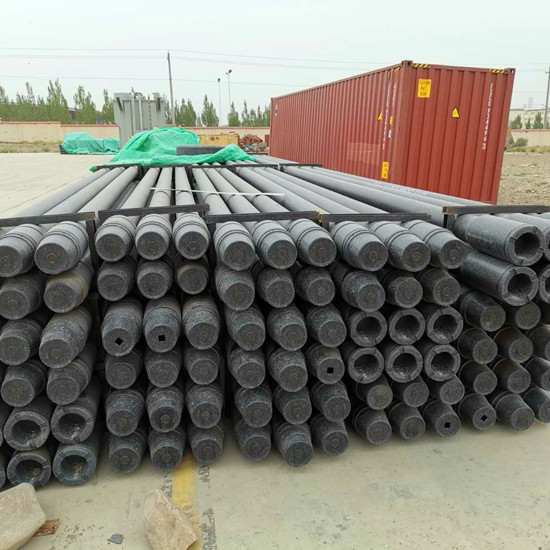
Drill pipe, is hollow, thin-walled, steel or aluminium alloy piping that is used on drilling rigs. It is hollow to allow drilling fluid to be pumped down the hole through the bit and back up the annulus. It comes in a variety of sizes, strengths, and wall thicknesses, but is typically 27 to 32 feet in length (Range 2). Longer lengths, up to 45 feet, exist (Range 3).
Drill stems must be designed to transfer drilling torque for combined lengths that often exceed several miles down into the Earth's crust, and also must be able to resist pressure differentials between inside and outside (or vice versa), and have sufficient strength to suspend the total weight of deeper components. For deep wells this requires tempered steel tubes that are expensive, and owners spend considerable efforts to reuse them after finishing a well.
A used drill stem is inspected on site, or off location. Ultrasonic testing and modified instruments similar to the spherometer are used at inspection sites to identify defects from metal fatigue, in order to preclude fracture of the drill stem during future wellboring. Drill pipe is most often considered premium class, which is 80% remaining body wall (RBW). After inspection determines that the RBW is below 80%, the pipe is considered to be Class 2 or "yellow band" pipe. Eventually the drill pipe will be graded as scrap and marked with a red band.
Drill pipe is a portion of the overall drill string. The drill string consists of both drill pipe and the bottom hole assembly (BHA), which is the tubular portion closest to the bit. The BHA will be made of thicker walled heavy weight drill pipe (HWDP) and drill collars, which have a larger outside diameter and provide weight to the drill bit and stiffness to the drilling assembly. Other BHA components can include a mud motor, measurement while drilling (MWD) apparatus, stabilizers, and various specialty downhole tools. The drill stem includes the entire drill string, plus the kelly that imparts rotation and torque to the drill pipe at the top.